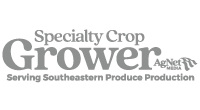By Wael Elwakil

Editor’s note: This article grants one continuing education unit (CEU) in the Core category toward the renewal of a Florida Department of Agriculture and Consumer Services restricted-use pesticide license when the accompanying test is submitted and approved.
Temperature inversion is a weather phenomenon that alters the natural air movement in the lower layer of the atmosphere (troposphere). Despite being a fairly common phenomenon under certain weather conditions, it usually goes unnoticed.


The diagrams show the air movement under normal weather conditions vs. temperature inversion conditions.
Images by Wael Elwakil, UF/IFAS
Where does temperature inversion occur?
Temperature inversion is more common in certain areas than in others. It occurs more frequently in lower altitude or secluded areas that are protected from the wind. This includes natural or artificial valleys, areas with natural barriers such as the side of a hill or a mountain, or near windbreaks such as high tree lines. These protected areas have lower chances of natural wind movement.
What happens during temperature inversion?
Under normal conditions, warm air rises from the warm earth’s surface and mixes with the cooler air layers as it moves upward. Wind speed plays a significant role in how quickly the different temperature air layers mix and dissipate. Under temperature inversion conditions, a horizontal warm air layer is suspended mid-air several feet above the ground surface to create a blockage that traps cooler air underneath. This layer disrupts the different temperature air layers from mixing normally. The air movement underneath the inversion layer is usually unpredictable depending on many factors such as the topography of the location and the altitude of the mid-air suspended inversion layer.
Why does temperature inversion go unnoticed?
Usually, temperature inversion goes unnoticed because there are no visual cues that indicate its occurrence. However, occasionally it can be noticed due to the presence of fog, smoke or smog in the air which helps highlight the inversion layer. This is often noticed over large fields or land depressions. This view of a suspended layer of fog or smog is commonly noticed on the sides of highways.
What are the types of temperature inversion?
Classifications and nomenclature can vary, but the types of temperature inversion refer to its formation and characteristics in the atmosphere.
Ground inversion, often referred to as radiation inversion, occurs when the ground cools rapidly during a clear night with calm wind conditions after a warm day. The air near the ground surface becomes cooler than the upper air layer that has formed from the radiating heat from the earth’s surface.
Subsidence inversion forms during a high-pressure system, where cold air from the upper layers of the atmosphere is compressed downward and descends due to its greater density than the warm air near the ground surface. The descended cold air layer absorbs warmth from the lower air layers creating a stable warm layer mid-air.
Frontal inversion forms when a cold air layer moves underneath warm air pushing it upward and creating a suspended boundary air layer.
Turbulence inversion forms when vertical air movement in the turbulent air near the ground surface transfers heat to an above stagnant air layer to create a mid-air boundary layer.
The different types of inversions have varying environmental impacts. However, ground or radiation inversion is the most common form of inversion in agricultural production fields and the most relevant to pesticide application. Occasionally inversion conditions can sometimes be referred to as air stagnation, a term known to fumigant applicators.
Why does temperature inversion matter to pesticide applicators?
Temperature inversions change the natural air movement. This can greatly impact pesticide application or fumigant drift, especially when it goes unnoticed. During ground inversion, the air under the boundary inversion layer can remain suspended near the surface (stagnation). Sometimes air may continue to move vertically near the surface. In the presence of wind, even at very low speeds, air near the earth’s surface moves horizontally and can potentially travel for very long distances.
In general, broadcasting liquid spray applications in agricultural fields or the rising volatiles of chemical products and fumigants will drift to some level. It is the job of the pesticide applicator to take measures to minimize any drift potential. Under normal weather conditions, experienced pesticide applicators will manage drift greatly to reduce or limit the movement beyond the application region or field.
Temperature inversion, however, adds a challenging complexity to any application where the spray particles’ deposition on the target location of the application is greatly reduced. This causes the spray particles to hover over the surface or horizontally move to long distances with any wind movement, even at low speeds. The primary risk of non-target drift is its impact on the environment, human health and wildlife. Phytotoxicity of other crops/plants is another risk. Additionally, due to the loss of the application away from the target area, growers lose the efficacy of a costly application, leaving diseases or pest issues unmanaged.
What applications have a high risk of drift?
While liquid spray broadcast applications will probably have the highest statistical probability of drift due to being the most commonly used method of pesticide application, there are a few other application methods that have a higher potential for drift. Air blast application in orchards and groves poses a higher risk of drift if air blast sprayers are not configured and calibrated properly. Volatile pesticide products that turn from liquid or solid product form to a gaseous form also have more risk of drift. Auxin-based herbicides such as dicamba and 2,4-D are highly volatile chemicals that are famous for off-target phytotoxicity or crop injury.
Also, the most commonly used soil fumigants are volatile. With their varying volatility characteristics, these products can escape into the atmosphere with high concentrations if applied inappropriately. Fumigation injection application of row crops where the injection is followed by laying plastic, especially, needs to be done with great care to reduce the risk of drift.
What type of conditions are right for temperature inversion?
Growers are always watching the weather, and some are more obsessed than others, and rightly so, as many farming decisions and pest management strategies are weather-dependent. But what do you need to look for to detect or predict temperature inversion? Temperature inversion is more likely to occur in the late afternoon and early morning.
The most common type of inversion, ground or radiation inversion, typically occurs when the sky is clear, with calm wind (less than 4 or 5 miles per hour), after a warm day followed by a cool night. These conditions will likely result in a temperature inversion. Dew and low-lying fog or smog can sometimes be accompanied by inversion and thus good visual cues to indicate the occurrence of inversion. It’s also important to know that temperature inversion conditions can last for prolonged periods.
How do I know if conditions are normal, and if it is a good time to spray?
When the sun rises and warms the earth’s surface, this starts breaking up and dissipating the inversion layer and allows for normal vertical air movement. If a low-laying fog or smog is lifting, that is a good indication of normal air layer movement and mixing. Overcast days can greatly slow that process. While temperature inversion is most likely to occur in the late afternoon or early morning, research shows that inversion conditions can occur throughout the day. These inversions are more difficult to detect and require specialized weather stations and close data monitoring.
What instruments can be used to detect or predict inversion?
There is no “out-of-the-box” solution or a product that can simply tell you that an inversion has occurred or is likely to happen. Weather stations or sensors can vary in complexity and accuracy when it comes to detecting or predicting the occurrence of an inversion. There are handheld temperature, wind and relative humidity sensors that are readily accessible and can be used to get baseline measurements to assist in detection.
There are weather stations that can collect temperature readings near the soil surface (6 to 12 inches) and at several feet above the ground (usually 8 to 10 feet or higher), where warmer temperatures at a higher altitude of about several degrees can indicate the presence of the warm boundary layer of the temperature inversion. Weather stations can also be coupled with wind and relative humidity sensors to assist with measuring air movement and dew levels. These weather stations can be very helpful for continuous and remote weather monitoring.
With all the benefits of on-farm weather stations, they have some limitations to be aware of. There are no exact weather parameter thresholds for inversion, so the data can only be used to generally guide and assist detection. A weather station can only provide data for one farm or location. Thus, the data is not useful for other distant locations or may not be representative of nearby locations with different topographies that may favor inversion conditions. Weather stations need to be covered from direct sunlight where the temperature data needs to be “shade temperature.”
Weather stations may be costly and require continued maintenance and reoccurring data subscription fees. The cost will also compound with the use of multiple other stations to get representative data for all the different fields. Yet, weather stations are powerful tools and can be tremendously helpful, especially when coupled with other sensors and functions such as frost monitoring, crop or disease models, growing degree days, chill-accumulation calculators and soil moisture monitoring.
How should spray equipment be configured?
Spray equipment can vary largely, and some models are highly specialized. Let’s think about the most common style of tractor-operated liquid sprayer as a model. The goal of a sprayer is to deliver liquid spray droplets with a certain level of uniformity to the plant canopy. There are essentially three main calibration areas: nozzles, pressure and speed.
To minimize drift, nozzle selection is critical. Start by picking a nozzle spray pattern based on your need. For example, contact pesticides require better coverage than systemic chemistries. And while flat fan nozzles and hollow cone nozzles have been the gold standard for many applicators, there are many comparable or even better nozzle technologies provided by many manufacturers. Next, select the right size or flow rate of the nozzle. Medium and coarse particle sizes are less prone to drift. Nozzle orientation and boom height are also important to get the best particle dispersion with a minimum travel distance to the plant canopy.
The lower the spray pressure you can use while getting a full spray pattern, the better. This will help ensure better deposition of the product as higher pressure tends to reduce the particle size and increase the potential for drift. There is a myth that using as much pressure as you can on a sprayer to atomize the spray droplets creating a mist or a fog-like spray is great for canopy coverage. Research has shown over and over that this practice in most spray conditions will reduce the downward deposition of your spray product on the plant canopy. Much of these very fine particles will travel upward or remain suspended in the air and eventually drift. So, refer to the manufacturer guides for the recommended nozzle pressure to achieve the desired flow rates and droplet sizes.
Lastly, drive at a reasonable speed to allow covering good acreage while maximizing product deposition on the plants without being suspended in the air for too long to reduce the chances of the product being blown away.
What are the key summary points?
The pesticide applicator is ultimately responsible for drift damage. Farmers should be able to recognize weather conditions that favor temperature inversion occurrence. Do not spray if inversion is detected, or favorable weather conditions are identified. Use handheld sensors or weather stations if available to assist in detecting temperature inversion. Don’t rely solely on weather stations for detection in distant locations or on a farm with different land topography. If inversion occurs, delay the pesticide application until the sun warms up the earth’s surface and breaks up the mid-air warm boundary layer. Optimize your pesticide sprayer to minimize drift. Monitor the movement of the spray at the start of and during the application to ensure good downward deposition with minimum levels of off-target movement.
Reference: Temperature Inversion… Your Pesticides Will Drift!
Wael Elwakil is a fruit and vegetable production agent with University of Florida Institute of Food and Agricultural Sciences Extension in Hillsborough County.
To request a hard copy of the article and test, or if you have questions regarding this article, test or CEUs, contact the author at wael.elwakil@ufl.edu at 813-836-0369. Please allow two weeks to process your CEU request.
Share this Post
Sponsored Content










